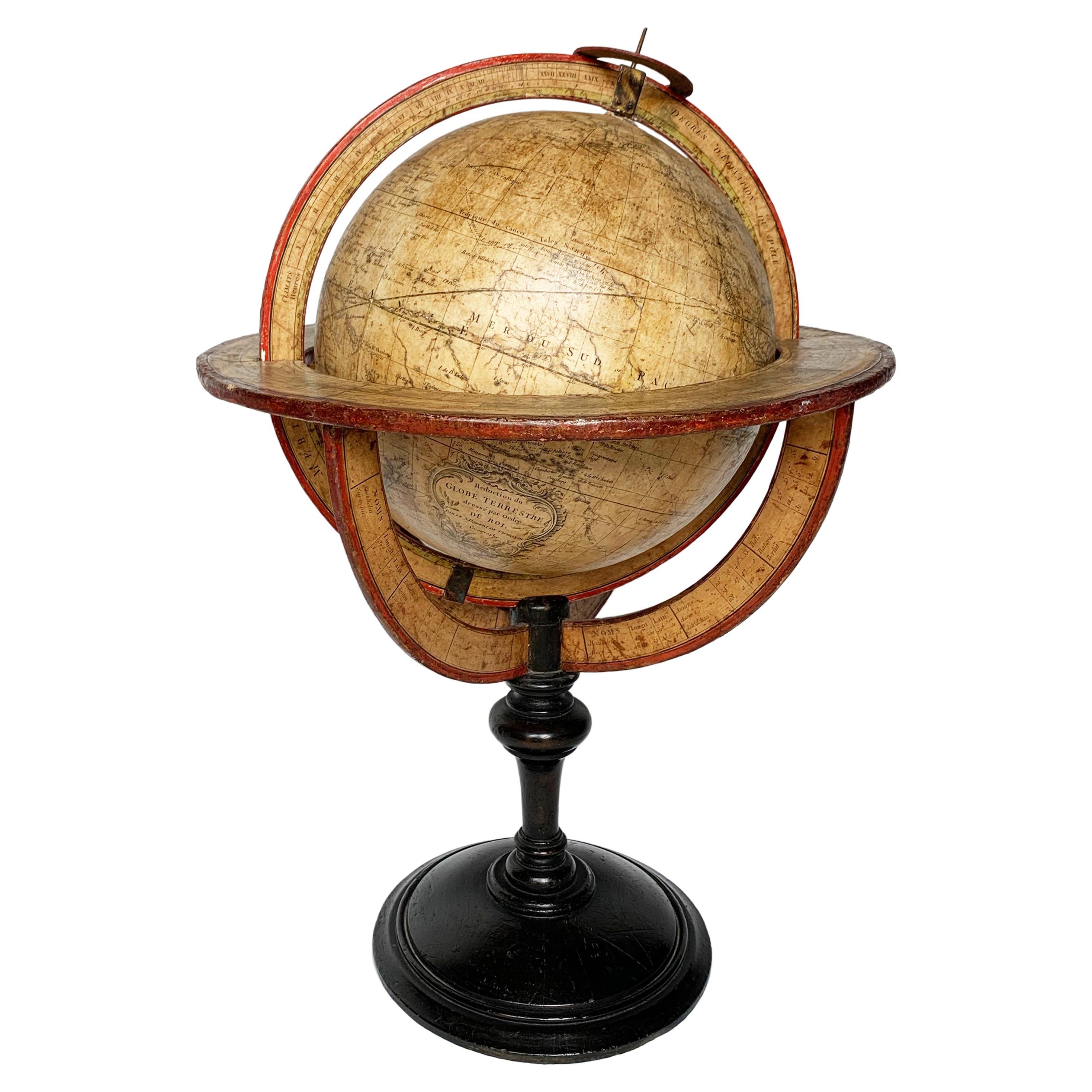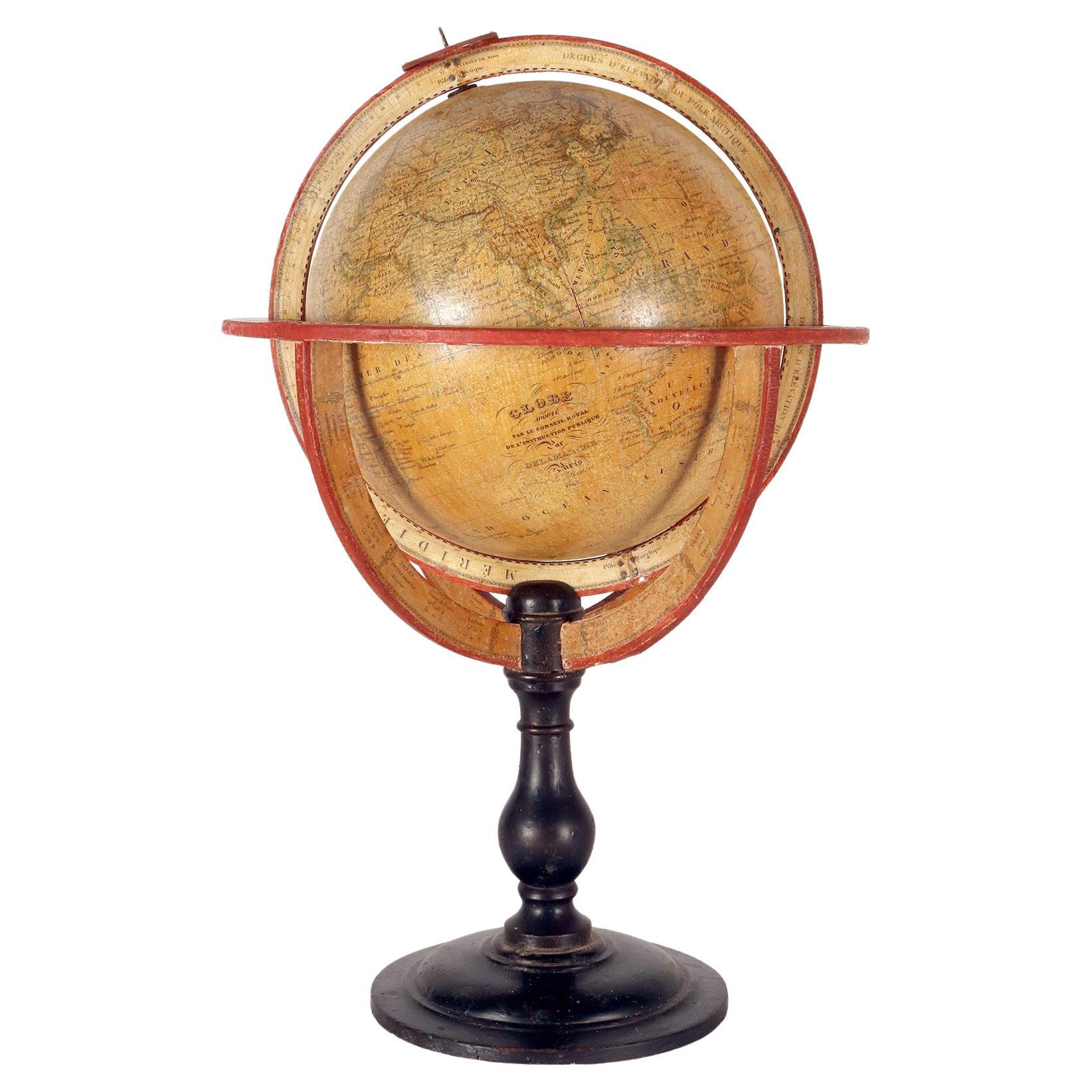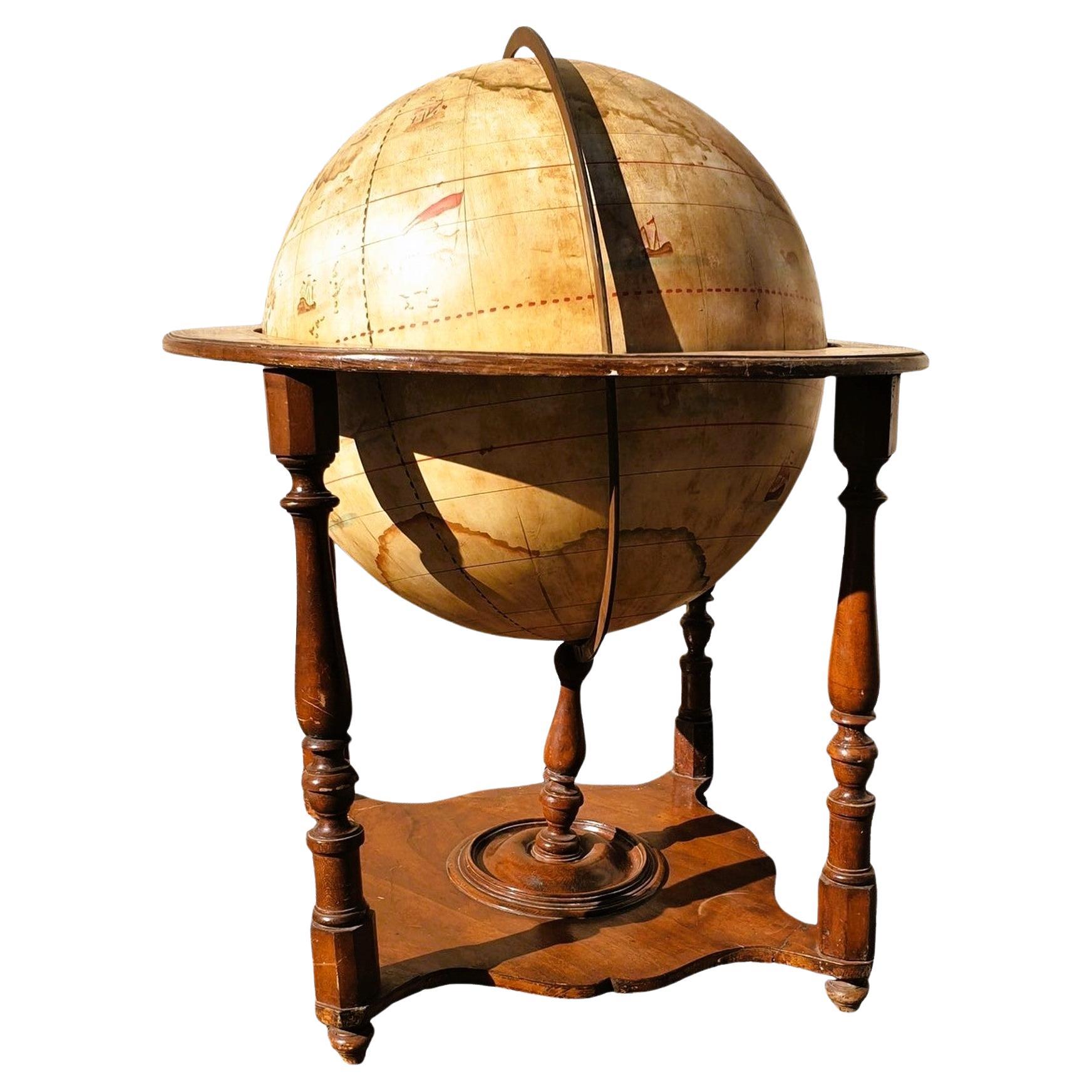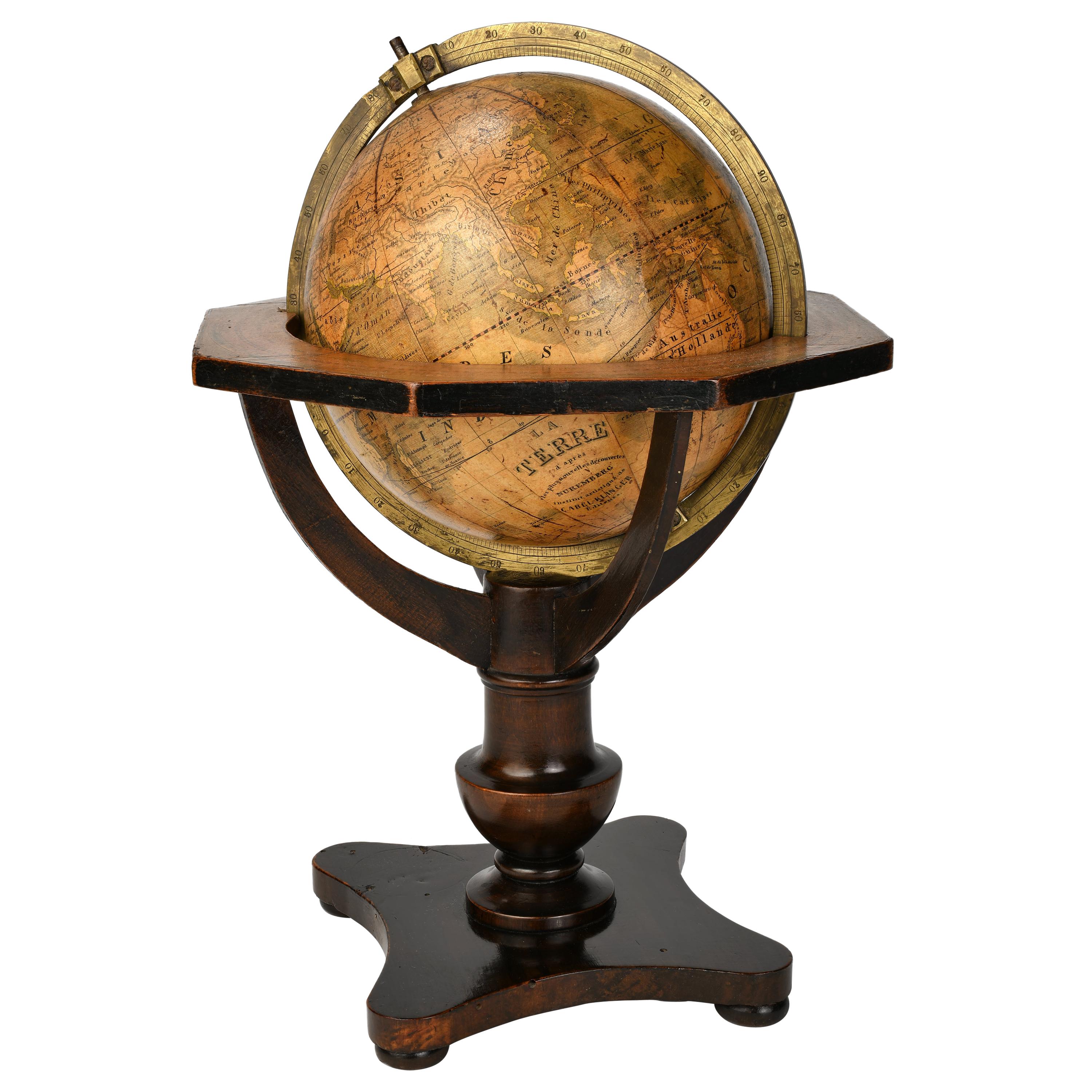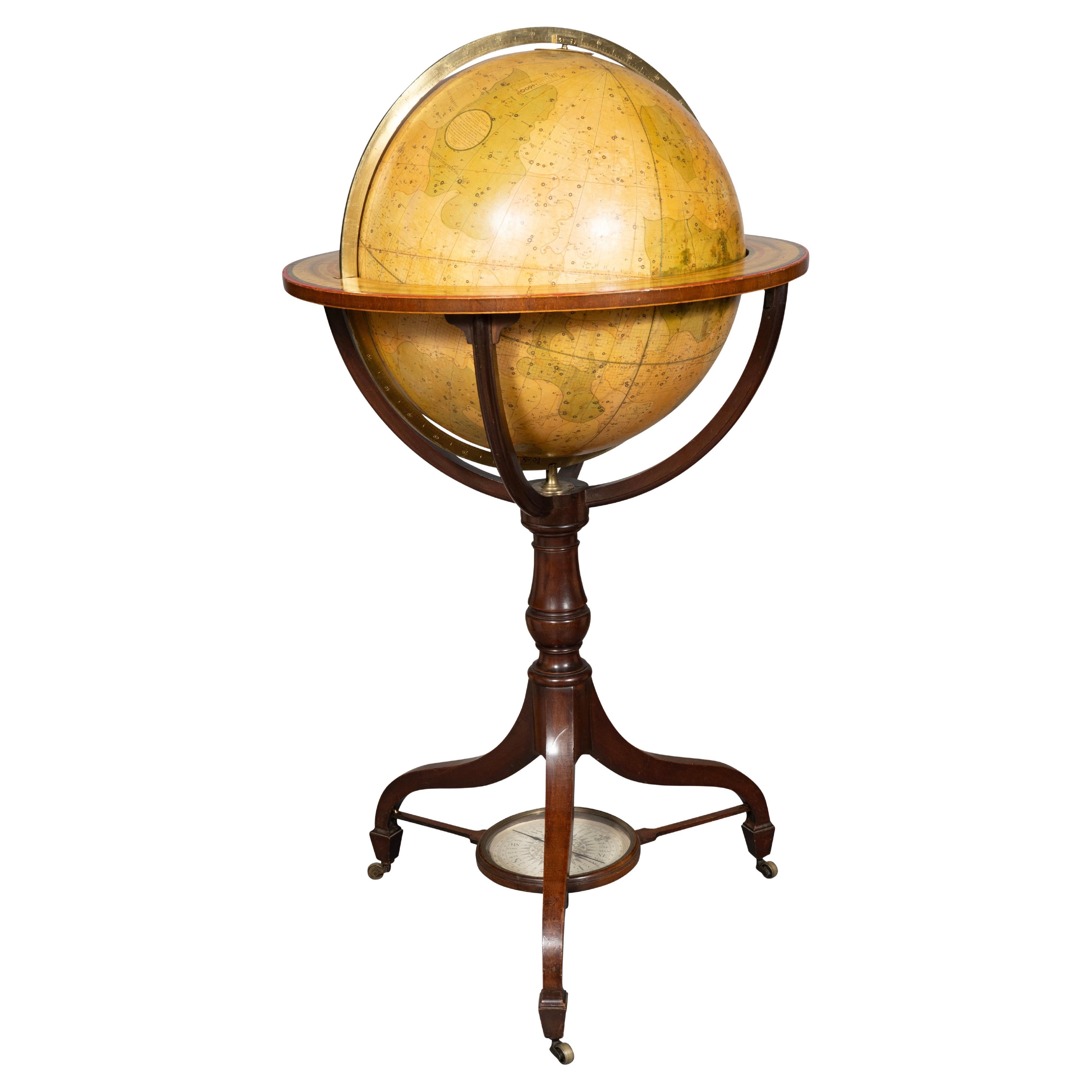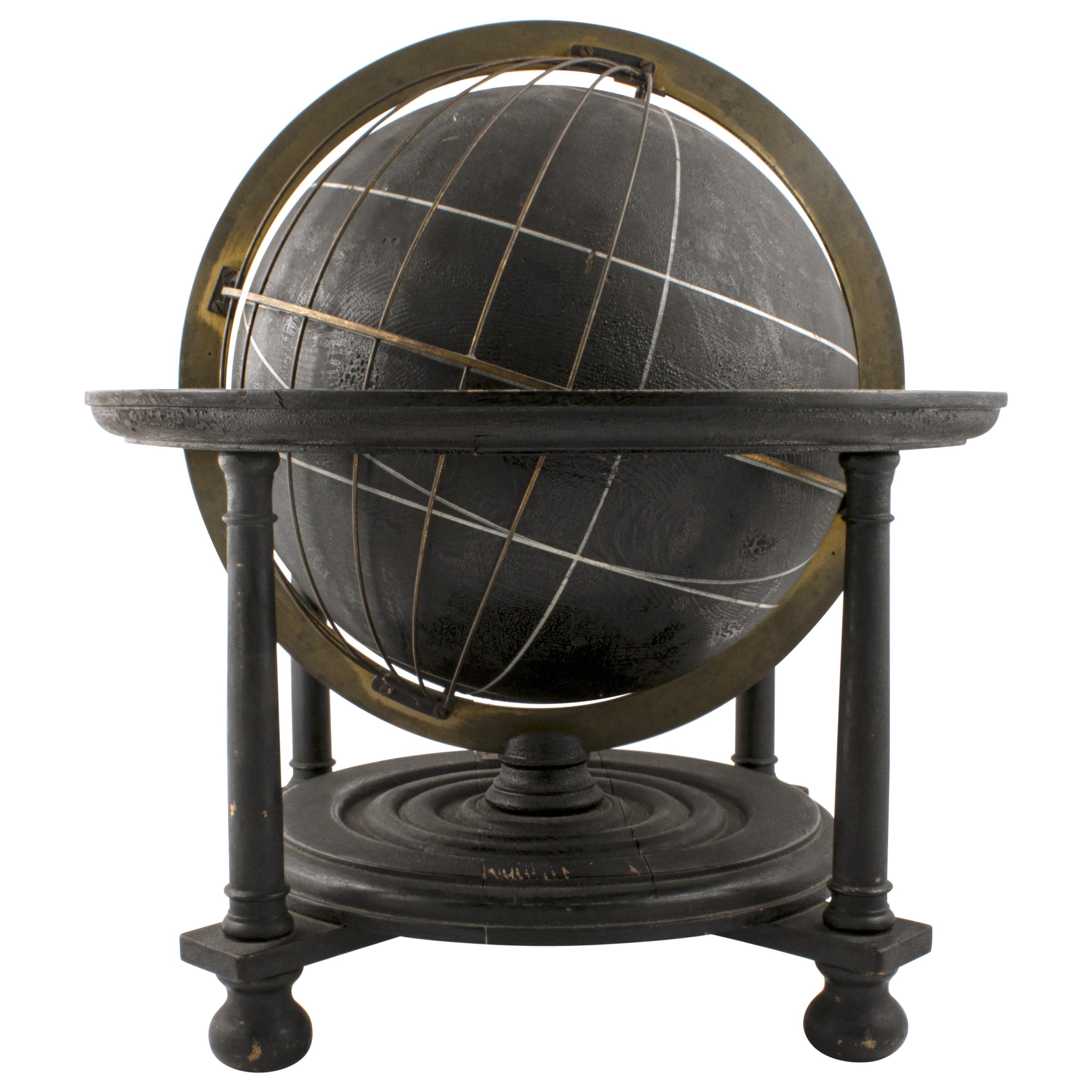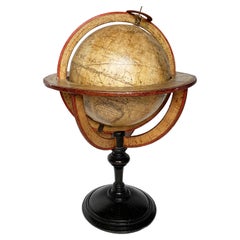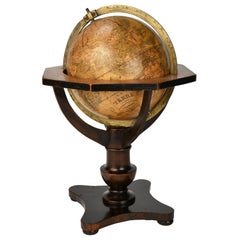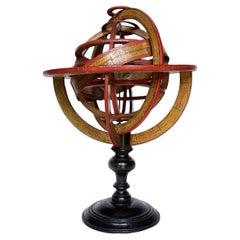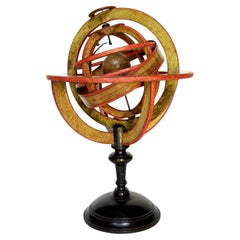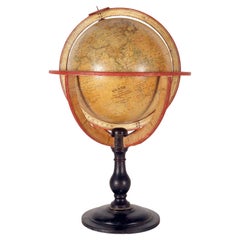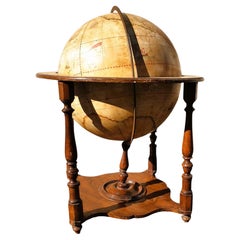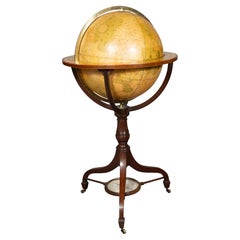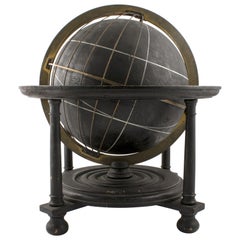Articoli simili a Celestial Table Globe, Charles-François Delamarche, Paris, 1791
Vuoi altre immagini o video?
Richiedi altre immagini o video al venditore
1 di 13
Celestial Table Globe, Charles-François Delamarche, Paris, 1791
6000 €IVA inclusa
Informazioni sull’articolo
Celestial table globe
Charles-François Delamarche
Paris, 1791
It measures: 17.13 in in height, Ø max 27.7 in; the sphere Ø 7.09 in
(h 43.5 cm x Ø max 27.7 cm; the sphere Ø 18 cm).
Weight: 2.96 lb (1,344 g)
Wood, paper, papier-mâché and metal
It rests on its original turned wooden column base.
State of conservation: there are small, slight gaps, abrasions, stains and cracks due to use and aging.
The globe is made of twelve printed paper gores, juxtaposed and glued onto a sphere composed of a gypsum-based composite material. The meridian circle and the horizon circle are made of wood and covered with printed paper.
The first has the degrees of latitude and the distances from the poles inscribed on it.
The horizon circle, instead, features the names of the zodiac with their related symbols and the months of the year, as well as both cardinal and intercardinal points.
Three separate cartouches appear on the sphere: one above Gemini, another at the North Pole, and a third between the latter and Perseus.
The first contains the inscription:
GLOBE
CELESTE
dans le quel les Etoilles
Fixes sont placées comme
elles sont apresent suivant
les derniers Observatio[ns]
des plus Célèbres
Astronomes de
ce Temps
The second, the northernmost, has a worn and difficult-to-read text, which can be summarized as follows: Cassini (Perinaldo, 1625 - Paris, 1712; Italian scientist naturalized French) calculated that the geographic pole describes a circle around the ecliptic pole over 24,800 years; the circle is drawn on the globe and every 15° marks how many years have passed since 1770, when the celestial pole was in this position.
The third bears the maker’s heading:
A PARIS
Chez le Sieur
Delamarche géo.
Rue du Foin St. Jacq.
au Collège de Me.
Gervais
Across the rest of the surface are depicted the constellations of the so-called "eighth sphere" (the domain of the fixed stars) and the circles that describe it: the equator, the meridian, the Tropic of Cancer, the Tropic of Capricorn, the polar circles and the ecliptic. Two examples of this same edition are held respectively at the Museum of the University of Groningen and the Library of the University of Amsterdam (Van der Krogt P. and Dekker E., Globes from the Western World, London 1993, p. 84 and Van der Krogt P., Old Globes in the Netherlands, Utrecht 1984, p. 101).
Charles-François Delamarche (1740-1817) founded his laboratory around 1770 and, in a few years, he became the most famous French cartographer and globe maker spanning the 18th and 19th centuries. After having acquired the laboratory of the late Didier Robert de Vaugondy (1723-1786; himself a renowned cartographer who continued the family business founded by his grandfather Nicolas Sanson in the seventeenth century) and after having purchased, between 1788 and around 1800, the businesses of Jean-Baptiste Fortin (1750-1831) and Jean Lattré (around 1750-1800), Delamarche began to call himself "Successeur de MM. Sanson and Robert de Vaugondi, Géographes du Roi and de M. Fortin, Ingénieur-mécanicien du Roi pour les globes et les sphères".
Thus, at the end of the eighteenth century, Delamarche possessed the warehouse stocks, as well as the manufacturing skills of the globes of his main rivals in Paris.
In addition to this aggressive acquisition policy, the key to his success also lay in the combination of high-quality cartography with extremely attractive globes and armillary spheres; and, of course, its famous red paint finishing touch.
His laboratory was located in Rue de Foin St Jacques "au Collège Me. (or "Mtre") Gervais" in the Latin Quarter of Paris until around 1805, when he moved to rue du Jardinet n. 13.
On the death of Charles-François in 1817, the reins of the company passed to his son Félix (1779-1835), who continued to publish, often in collaboration with the engraver Charles Dien, Senior. In 1835 the company first moved to rue du Jardinet n. 12 and a little later to rue du Battoir n. 7.
Bibliography:
Van der Krogt P., Old Globes in the Netherlands, Utrecht 1984, p. 101;
Van der Krogt P. e Dekker E., Globes from the Western World, London 1993, p. 84;
Dekker E., et al., Globes at Greenwich: A Catalogue of the Globes and Armillary Spheres in the National Maritime Museum, Greenwich, London, 1999, pp. 321 for the story of the Delamarche family.
- Creatore:Charles Francois Delamarche (Fabbricante)
- Dimensioni:Altezza: 43,5 cm (17,13 in)Diametro: 27,7 cm (10,91 in)
- Stile:Altro (Del periodo)
- Materiali e tecniche:
- Luogo di origine:
- Periodo:1790-1799
- Data di produzione:1791
- Condizioni:Usura compatibile con l’età e l’utilizzo. There are small, slight gaps, abrasions, stains and cracks due to use and aging.
- Località del venditore:Milano, IT
- Numero di riferimento:1stDibs: LU4352245213782
Informazioni sul venditore
4,3
Venditore professionale selezionato
Ogni venditore supera rigorosi standard di autenticità e affidabilità
Fondazione nel 1860
Venditore 1stDibs dal 2018
21 vendite su 1stDibs
Associazioni
International Confederation of Art and Antique Dealers' Associations
- SpedizioneRecupero del preventivo…Spedizione da: Milano, Italia
- Politica di reso
Alcune parti di questa pagina sono state tradotte automaticamente. 1stDibs non può garantire che le traduzioni siano corrette. L’inglese è la lingua predefinita del sito.
Garanzia di autenticità
Nell’improbabile caso in cui si verifichi un problema con l’autenticità di un articolo, contattaci entro un anno per ottenere un rimborso completo. DettagliGaranzia di rimborso
Se il tuo articolo non corrisponde alla descrizione, è danneggiato durante il trasporto o non arriva, contattaci entro 7 giorni per un rimborso completo. DettagliAnnullamento entro 24 ore
Hai un periodo di tolleranza di 24 ore per annullare il tuo acquisto, senza necessità di fornire spiegazioni.Venditori professionali selezionati
I nostri venditori di livello internazionale devono aderire a rigorosi standard di servizio e qualità, garantendo l’integrità delle inserzioni.Garanzia miglior prezzo
Se scopri che un venditore ha pubblicato altrove lo stesso articolo a un prezzo più basso, applicheremo lo stesso prezzo.Consegna globale affidabile
La nostra rete di vettori leader del settore offre opzioni di spedizione specializzate in tutto il mondo, inclusa la consegna personalizzata.Altro da questo venditore
Mostra tuttoGlobo da tavolo terrestre di Félix Delamarche, Parigi, 1821
Di Félix Delamarche
Globo terrestre da tavolo
Félix Delamarche
Parigi, 1821
Misura 20,47 pollici di altezza, Ø max 14,17 pollici; la sfera Ø 9,44 pollici (h 52 cm x Ø max 36,5 cm; la sfera Ø 24 cm).
...
Categoria
Di antiquariato/d’epoca, Anni 1820, Francese, Restaurazione, Strumenti s...
Materiali
Metallo
Mappamondo tedesco di C. Abel-Klinger, Norimberga, 1860 ca.
Di C. Abel-Klinger
Globo terrestre
Compagnia artistica C. Abel - Klinger
Norimberga, 1860 circa
H. 31 x 22 cm (12,20 x 8,66 pollici); sfera di 14 cm (5,51 pollici) di diametro
lb 2,30 (kg 1,04)
Stato d...
Categoria
Di antiquariato/d’epoca, Anni 1860, Tedesco, Altro, Strumenti scientifici
Materiali
Legno, Carta
Ptolemaic Armillary Sphere, Charles-François Delamarche, Parigi, ante 1798
Di Charles Francois Delamarche
Ptolemaic armillary sphere
Charles-François Delamarche
Parigi, ante 1798
Wood and papier-mâché
covered with printed and partly hand-coloured paper
It measures 15.55 in in height x Ø ...
Categoria
Di antiquariato/d’epoca, 1790s, French, Altro, Strumenti scientifici
Materiali
Legno, Carta
Ptolemaic Armillary Sphere, Charles-François Delamarche, Paris, ante 1798
Di Charles Francois Delamarche
Ptolemaic armillary sphere
Charles-François Delamarche
Paris, ante 1798
Wood and papier-mâché
covered with printed and partly hand-coloured paper
It measures 16.37 in in height x Ø 1...
Categoria
Di antiquariato/d’epoca, 1790s, French, Altro, Strumenti scientifici
Materiali
Legno, Carta
Sfera armillare tolemaica Charles Charles-François Delamarche Paris, 1805-1810 Circa
Di Charles Francois Delamarche
Charles Charles Delamarche
La sfera armillare tolemaica
Parigi, circa 1805-1810
Wood e cartapesta
ricoperto di carta stampata e in parte colorata a mano
Misura 15,74" di altezza e 11...
Categoria
Di antiquariato/d’epoca, Inizio Ottocento, Francese, Stile impero, Strum...
Materiali
Carta, Legno
Globo da 18 pollici, Cary, London, 1840
Di Cary’s
John & William Carys
Aggiornato da George & John Carys
Globo terrestre
Londra, 1840
lb 22 (kg 10)
Lievi abrasioni superficiali dovute all'uso. Una piccola crepa sul cerchio dell'or...
Categoria
Di antiquariato/d’epoca, Anni 1840, Inglese, Primo vittoriano, Globi ter...
Materiali
Carta, Legno
Ti potrebbe interessare anche
Un globo terrestre di sette pollici, firmato Felix Delamache, Francia 1845.
Di Félix Delamarche
Mappamondo in legno e cartapesta inciso. Equatore appoggiato su quattro quarti di meridiani su una base in legno tornito a frutta nera con profilo mosso e base circolare.
Il mappamon...
Categoria
Di antiquariato/d’epoca, Anni 1840, Italiano, Strumenti scientifici
Materiali
Legno, Carta
Globo terrestre da biblioteca su supporto, fine XIX inizio XX secolo
Grande globo terrestre in cartapesta e gesso, fissato nel suo cesto di legno: i fusi sono dipinti con i continenti (in modo decorativo), il meridiano completo è in ottone; il cerchio...
Categoria
Di antiquariato/d’epoca, Fine XIX secolo, Italiano, Rinascimento, Strume...
Materiali
Legno, Carta
Globo da terra celeste George III di J&W Cary's
Cary's New and Improved Celestial globe. Datato 1799. Cary's era uno dei principali produttori di mappamondi inglesi della fine del XVIII secolo. Incastonato in un supporto in mogano...
Categoria
Di antiquariato/d’epoca, Fine XVIII secolo, Inglese, Giorgio III, Globi ...
Materiali
Ottone
Globo celeste, Svezia, inizio XIX secolo
Mappamondo celeste in legno nero in condizioni originali.
Legno annerito, cerchio dell'orizzonte e anelli in ottone con misure di longitudine.
Montato su un cavalletto in legno con...
Categoria
Di antiquariato/d’epoca, Inizio XIX secolo, Globi terrestri
Materiali
Legno
Globo celeste del XIX secolo di Charles Dien, firmato e dedicato a M. A. Bouv
Raro ed elegante mappamondo celeste del XIX secolo firmato: "Dédié à M. A. Bouvard... / par Ch. Dien". Creato da Charles Dien, noto costruttore di globi francese, questo pezzo presen...
Categoria
Di antiquariato/d’epoca, Anni 1850, Strumenti scientifici
Materiali
Legno di alberi da frutto
Globo terrestre del XIX secolo di G. Thomas, editore e costruttore di globi, Parigi, anni '90 del XIX secolo
Di G. Thomas, Éditeur
Raro mappamondo terrestre del XIX secolo di G. Thomas, Editeur & Globe Maker, Parigi, 1890 circa
Il mappamondo si trova su un supporto di legno e misura 4" di diametro x 6,5" di a...
Categoria
Di antiquariato/d’epoca, Fine XIX secolo, Francese, Globi terrestri
Materiali
Carta
